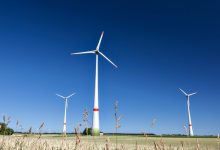For a long time, investing in and running a wind or solar park in Germany was both safe and easy: the network connection was guaranteed, green power had priority access to the grid and most importantly, every kilowatt-hour (kWh) delivered was paid for at a set feed-in remuneration, guaranteed for 20 years.
This – in a nutshell – is what made Germany’s renewable energy boom of the past two decades possible.
Generous and guaranteed feed-in tariffs under Germany’s Renewable Energy Act (EEG) saw the share of renewable power, mostly coming from wind, solar PV and biomass, in electricity generation rise from about 3.5 percent in 1990 to 35 percent in 2018.
But as of 2021, more and more renewable installations will lose their guaranteed funding as their 20 years of EEG payments come to an end.
If all of these installations simply ceased to operate this would amount to a loss of many gigawatts of renewable capacity at a time when the government looks set to raise its ambitions in greenhouse gas reduction and wants to increase the share of renewables in power consumption to 65 percent by 2030 to pave the way for the electrification of all sectors – but struggles to meet those targets.
While this would be an unlikely worst-case scenario, experts are still worried about the uncertainty that many of the old renewable installations face. Will they be able to operate economically, banking only on a fluctuating or too low wholesale power price?
Will the many operators of very small renewable installations be able to market their electricity?
Will legal framework conditions be favourable to the renewable producers that enter the free market for the first time? These are just some questions that particularly Germany’s wind, solar and biogas associations but also grid operators are concerned about when looking towards the 2020s.
New business model for every individual renewable operation
“There is no one-size-fits-all solution,” Philine Derouiche, a lawyer at the German Wind Energy Association (BWE), said. The future options for old or rather “pioneer” wind parks hinge on their capacity, the condition of the turbines, their location and their operating costs, she explained.
“The capability of a pioneer wind park to continue its operations on the free market primarily depends on its maintenance costs,” she told Clean Energy Wire.
Reinhard Christiansen, operator of several wind farms in Germany’s windy northern state of Schleswig-Holstein, has already gone through the motions of ensuring the future of his pioneer wind farm. As of 2021, he will sell the electricity of his six turbines in Ellhöft, with 1.3 megawatt capacity each, to power provider Greenpeace Energy.
According to their contract, Greenpeace Energy will pay an agreed base price for the electricity, which is adjusted if the wholesale price on the electricity exchange should be higher.
It is this kind of so-called power purchase agreements (PPA), often long-term delivery agreements, that many experts think will become the new default procedure after the feed-in tariff period ends. Under PPAs, the buyer bears the risk of weather-related fluctuations in power supply but therefore only guarantees a limited remuneration per kWh.
In a survey by Germany’s energy agency dena, over 85 percent of surveyed market representatives said PPAs are “important” or “very important” for the country’s renewable energy future. The main reason for this was the prospect of price stability and older installations dropping out of the EEG support scheme were seen as most suitable for this purpose.
Source: Clean Energy Wire. Reproduced with permission.











